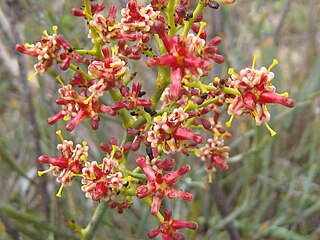
John Lindley FRS was an English botanist, gardener and orchidologist.

Banksia armata, commonly known as prickly dryandra, is a species of often sprawling shrub that is endemic to Western Australia. It has deeply serrated leaves with sharply pointed lobes and spikes of about 45 to 70 yellow flowers.

Banksia nobilis, commonly known as the golden dryandra, great dryandra or kerosene bush, is a shrub of the family Proteaceae which is endemic to Western Australia. It occurs on lateritic rises from Eneabba to Katanning in the state's Southwest Botanic Province. With large pinnatifid leaves with triangular lobes, and a golden or reddish pink inflorescence, it is a popular garden plant. It was known as Dryandra nobilis until 2007, when all Dryandra species were transferred to Banksia by Austin Mast and Kevin Thiele. There are two subspecies, B. nobilis subsp. nobilis and B. nobilis subsp. fragrans.
Banksia proteoides, commonly known as king dryandra, is a shrub endemic to Western Australia. It was known as Dryandra proteoides until 2007, when all Dryandra species were transferred to Banksia by Austin Mast and Kevin Thiele.

Banksia stuposa is a species of shrub that is endemic to the southwest of Western Australia. It has hairy stems, broadly linear pinnatifid leaves, golden yellow and white flowers in heads of one hundred or more, and hairy, egg-shaped follicles.

Grevillea flexuosa, commonly known as zigzag grevillea or tangled grevillea, is an endangered shrub endemic to Western Australia.
Conospermum acerosum, commonly known as needle-leaved smokebush, is a shrub endemic to Western Australia
Conospermum glumaceum, commonly known as hooded smokebush, is a shrub endemic to Western Australia.
Conospermum stoechadis subsp. sclerophyllum is a shrub endemic to Western Australia.
Conospermum incurvum, commonly known as plume smokebush, is a shrub endemic to Western Australia.

Stirlingia simplex is a plant endemic to Western Australia.

Stirlingia latifolia, commonly known as blueboy, is a plant endemic to Western Australia.

The Botanical Register, subsequently known as Edwards's Botanical Register, was an illustrated horticultural magazine that ran from 1815 to 1847. It was started by the botanical illustrator Sydenham Edwards, who had previously illustrated The Botanical Magazine, but left after a dispute with the editors. Edwards edited five volumes of The Botanical Register in five years, before his death in 1819. During this period, the text was provided by John Bellenden Ker Gawler, and Edwards himself provided paintings, which were engraved and hand-coloured by others.

Diuris corymbosa, commonly called the common donkey orchid or wallflower orchid, is a species of orchid which is endemic to the south-west of Western Australia. It is similar to the purple pansy orchid but its flowers are yellow rather than purple or mauve and it flowers earlier in the year. It also resembles the winter donkey orchid but flowers later than that species. It is one of the most common orchid species in the Perth area, often forms extensive colonies and usually has numerous flowers on the one spike.
Enumeratio plantarum quas in Novae Hollandiæ ora austro-occidentali ad fluvium Cygnorum et in sinu Regis Georgii collegit Carolus Liber Baro de Hügel is a description of the plants collected at the Swan River colony and King George Sound in Western Australia. The author, Stephan Endlicher, used a collection arranged by Charles von Hügel to compile the first flora for the new settlements. Hugel visited the region during 1833–1834, several years after the founding of the colony. The work provided formal descriptions, in Latin, of new species and genera of plants. The single instalment was produced in Europe by Endlicher in 1837, the work also included contributions by Eduard Fenzl, George Bentham, Heinrich Wilhelm Schott.

Drosera heterophylla, the swamp rainbow, is an erect perennial tuberous species in the carnivorous plant genus Drosera that is endemic to Western Australia. It grows in shallow water swamps or wet clay flats near granite outcrops and occurs in the vicinity of Perth and to its north. D. heterophylla produces small leaves along an erect stem that can be 10–30 cm (4–12 in) tall. It is the only species in the genus that produces many-petaled flowers. These white flowers emerge from June to September.

Pithocarpa is a genus of Australian plants in the pussy's-toes tribe within the daisy family.

{{taxobox |image = Asteridea pulverulenta - Flickr - Kevin Thiele.jpg |image_caption = Asteridea pulverulenta |regnum = Plantae |unranked_divisio = Angiosperms |tribus=Gnaphalieae |unranked_classis = Eudicots |unranked_ordo = Asterids |ordo = Asterales |familia = Asteraceae |genus = Asteridea |genus_authority = Lindl. |type_species = Asteridea pulverulenta |type_species_authority = Lindl. }} Asteridea is a genus of flowering plants in the daisy family. Evidence suggests that the genus, Asteridea, is monophyletic.

Adenanthos barbiger, the hairy jugflower or hairy glandflower, is a species of shrub in the family Proteaceae. It is endemic to the south-west of Western Australia. It usually grows to 1 metre high, and has bright red flowers that appear mostly between August and December. The species was first formally described in 1839 by English botanist John Lindley in A sketch of the vegetation of the Swan River colony.

Scaevola canescens is a species of plant in the family Goodeniaceae. It is endemic to Western Australia where it occurs "from Shark Bay to Perth, in open forest and heath in sandy soil".














